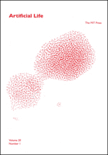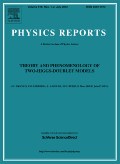
Physics of Life Reviews
Scope & Guideline
Pioneering Reviews in the Physics of Life
Introduction
Aims and Scopes
- Interdisciplinary Research:
The journal promotes research that spans multiple disciplines, including physics, neuroscience, biology, and psychology, fostering a holistic understanding of life and consciousness. - Modeling Biological Systems:
A significant emphasis is placed on mathematical and computational modeling to explore biological processes, particularly in areas like evolutionary dynamics, cancer biology, and cognitive science. - Consciousness and Cognition:
Research on the mechanisms of consciousness, perception, and cognition is a core focus, particularly studies that integrate neurobiological and psychological perspectives. - Self-Organization and Complexity:
The journal highlights the principles of self-organization and complexity in biological systems, exploring how these concepts can explain emergent behaviors in living organisms. - Biophysical Mechanisms:
Investigations into the biophysical mechanisms underlying various biological phenomena, such as mechanotransduction and electrical properties of cells, are central to the journal's scope.
Trending and Emerging
- Integrative Approaches to Consciousness:
There is an increasing focus on integrative frameworks that combine neuroscience, psychology, and physics to understand consciousness, reflecting a growing interest in interdisciplinary methodologies. - Applications of Machine Learning:
The use of machine learning techniques to analyze complex biological data is trending, showcasing a blend of computational methods with traditional biological research. - Mechanotransduction in Health and Disease:
Research on mechanotransduction—the process by which cells sense and respond to mechanical stimuli—is gaining prominence, especially in its implications for health and disease, such as in cancer and osteoarthritis. - Environmental Influences on Biological Systems:
Studies examining how environmental factors impact biological processes are increasingly prevalent, aligning with global concerns about climate change and sustainability. - Collective Behavior and Swarm Intelligence:
There is a notable rise in research exploring collective behavior in biological systems, including swarm intelligence in animals and its implications for understanding complex adaptive systems.
Declining or Waning
- Traditional Reductionism:
Research that primarily adopts a reductionist approach to biological systems has seen a decline, as there is a growing preference for integrative and systems-based perspectives. - Purely Theoretical Models:
The emphasis on purely theoretical models without empirical validation appears to be waning, with a noticeable shift towards studies that incorporate experimental data and real-world applications. - Static Biological Systems:
Studies concentrating on static models of biological systems are becoming less common, as there is a trend towards dynamic modeling that accounts for temporal changes and interactions within systems. - Focus on Individual Species:
Research focused solely on individual species without considering ecological interactions and evolutionary dynamics is decreasing, as interdisciplinary studies become more favored. - Cognitive Mechanisms without Context:
Investigations of cognitive mechanisms that do not consider environmental, social, or cultural contexts are less frequently published, reflecting a shift towards more contextualized approaches.
Similar Journals

ARTIFICIAL LIFE
Transforming Perspectives on Biology and ComputationARTIFICIAL LIFE, published by MIT PRESS, is a premier academic journal dedicated to the interdisciplinary study of artificial life, exploring the intersection of biology, computer science, and related fields. With an impact factor that reflects its influential contributions—especially highlighted in its Q3 rankings in Artificial Intelligence, Biochemistry, Genetics and Molecular Biology, and Ecology, Evolution, Behavior and Systematics—the journal serves as a critical platform for researchers, professionals, and students alike. Originating in 1995, ARTIFICIAL LIFE continues to publish cutting-edge research that pushes the boundaries of our understanding of life-like systems, both natural and synthetically designed. Despite having limited open access options, the journal’s role in fostering innovative discussions and advancements in its field cannot be overstated, making it an essential resource for anyone engaged in the study and application of artificial life concepts.

CONSCIOUSNESS AND COGNITION
Advancing Insights into Conscious ExperienceConsciousness and Cognition is a prestigious academic journal dedicated to advancing the understanding of cognitive processes and consciousness. Published by Academic Press Inc, Elsevier Science, the journal has maintained a prominent presence in the field since its inception in 1992, reaching a converged publication timeline through 2024. With an impact factor reflecting its high relevance, it holds a Q1 rank in Arts and Humanities and Q2 ranks in both Developmental and Educational Psychology and Experimental and Cognitive Psychology as of 2023. Researchers and academics utilize this journal as a critical resource for the latest empirical findings, theoretical advancements, and innovative methodologies in understanding the intricacies of human cognition and conscious experience. Although it does not offer open access, the journal’s extensive contributions help shape active dialogues within this interdisciplinary domain, making it essential reading for professionals, researchers, and students alike striving to explore the mysteries of consciousness.

Nonlinear Dynamics Psychology and Life Sciences
Exploring the Complex Interplay of Mind and LifeNonlinear Dynamics Psychology and Life Sciences is a leading journal published by the SOC CHAOS THEORY PSYCHOLOGY & LIFE SCIENCES, focusing on the intersection of nonlinear dynamics and psychological phenomena as well as their implications in life sciences. With an ISSN of 1090-0578 and an E-ISSN of 1573-6652, this journal stands out as a reputable source of innovative research and analytical studies that contribute significantly to the fields of applied mathematics and psychology. By delving into the complex behaviors and patterns of dynamic systems, the journal addresses vital contemporary issues, making it essential reading for researchers, professionals, and students alike. Although it operates on a traditional access model, the journal's insights are invaluable for understanding the empirical background behind nonlinear dynamics in psychological research. Recognized within the academic community for its contributions, it holds a 2023 Scopus ranking of #436 out of 635 in the Applied Mathematics category, placing it in the 31st percentile, and it is designated as Q3 in its quartile categorization. As a bridge between theoretical foundations and real-world applications, Nonlinear Dynamics Psychology and Life Sciences aims to foster interdisciplinary dialogue and inspire future research in this exciting and evolving field.

Natural Sciences
Empowering researchers through open access to groundbreaking discoveries.Natural Sciences is a premier journal published by WILEY, dedicated to advancing the interdisciplinary field of natural sciences through the dissemination of high-quality research. With an ISSN of 2698-6248, this publication features original contributions that explore a wide range of topics including biology, chemistry, physics, and environmental science. Despite the current absence of an impact factor, the journal's commitment to rigorous peer-review ensures the integrity and relevance of its scholarly work. Situated at the forefront of scientific inquiry, Natural Sciences serves as a vital resource for researchers, professionals, and students looking to stay informed about the latest breakthroughs and methodologies in the natural sciences. Emphasizing open access principles, this journal strives to make cutting-edge research readily available to a global audience, fostering collaboration and innovation across disciplines.

Biological Theory
Illuminating the Pathways of Life SciencesBiological Theory is an esteemed academic journal published by Springernature, focusing on the interdisciplinary realms of ecology, evolution, behavior, and philosophy of science. With an ISSN of 1555-5542 and an E-ISSN of 1555-5550, the journal had its converged years from 2006 to 2011 and from 2013 to 2024, reflecting its commitment to ongoing scholarly dialogue. Notably, it holds a prestigious Q2 ranking in Ecology, Evolution, Behavior and Systematics, and an impressive Q1 ranking in History and Philosophy of Science, highlighting its influential role in shaping discussions across these fields. The journal is well-received in the academic community, with Scopus rankings placing it in the 88th percentile for History and Philosophy of Science and the 59th percentile for Ecology, demonstrating its broad impact and relevance. Researchers, professionals, and students can access cutting-edge theories and critical analyses of biological concepts that contribute to a deeper understanding of life sciences without an open access model, further emphasizing the journal's significance in both historical and contemporary scientific discourse.

REVIEWS OF MODERN PHYSICS
Unveiling the Depths of Modern PhysicsREVIEWS OF MODERN PHYSICS, published by the American Physical Society, stands as a premier journal in the field of physics and astronomy, evidenced by its esteemed Q1 ranking in the 2023 category. With a notable ISSN of 0034-6861 and E-ISSN of 1539-0756, this journal has been a cornerstone for scholarly excellence since its inception in 1929. Operating from the heart of the United States at One Physics Eklipse, College Park, MD 20740-3844, REVIEWS OF MODERN PHYSICS enjoys a significant reputation, holding a top rank of #1 out of 243 in the Scopus rankings for General Physics and Astronomy, and securing its place in the 99th percentile. While it does not provide open access, the journal remains a critical resource for researchers and students alike, offering comprehensive reviews and breakthroughs that drive innovation and understanding in modern physics. As it converges towards its centennial year in 2024, the journal continues to foster significant academic discourse, making it an invaluable platform for the dissemination of pioneering ideas and research outcomes.

THEORY IN BIOSCIENCES
Fostering Scholarly Communication for Global ImpactTHEORY IN BIOSCIENCES, published by SPRINGER, is a prominent academic journal in the interdisciplinary fields of Applied Mathematics, Ecology, and Statistics. With an ISSN of 1431-7613 and an E-ISSN of 1611-7530, this journal is accessible to a global audience and facilitates Open Access options, ensuring that cutting-edge research reaches its intended audience promptly. Established in 1997 and set to converge into 2024, THEORY IN BIOSCIENCES holds a pivotal role in advancing theoretical and methodological approaches in biosciences, evidenced by its respectable placement in the Q3 quartile within the 2023 category rankings. Its Scopus rankings reflect a growing reputation, particularly in Mathematics and Ecology, making it an essential resource for researchers and professionals seeking to enhance their understanding of complex biological systems and data analysis techniques. Positioned in Germany and powered by SPRINGER's esteemed publishing standards, the journal is dedicated to fostering scholarly communication, offering a platform for innovative research that bridges theoretical frameworks and practical applications.

PHYSICAL BIOLOGY
Decoding Life's Complexities Through a Physical LensPHYSICAL BIOLOGY is a prominent journal published by IOP Publishing Ltd, focusing on the interdisciplinary field of biophysics, cell biology, molecular biology, and structural biology. Established in 2004, this journal has quickly made its mark in the academic community, currently ranking in the Q2 category in Biophysics and Q3 in Cell, Molecular, and Structural Biology as of 2023. With an ISSN of 1478-3967 and E-ISSN 1478-3975, it serves as a vital platform for disseminating groundbreaking research that bridges physical principles with biological systems. While currently not providing Open Access options, the journal offers access to a wealth of knowledge crucial for researchers, professionals, and students alike who are eager to explore the intricacies of living organisms through a physical lens. Situated in the United Kingdom, PHYSICAL BIOLOGY emphasizes the importance of multiscale approaches and innovative techniques, making it an essential resource for those working at the intersection of physics and biology.

PHYSICS REPORTS-REVIEW SECTION OF PHYSICS LETTERS
Delivering comprehensive reviews for the curious mind.Physics Reports - Review Section of Physics Letters is a prestigious journal published by Elsevier, dedicated to providing comprehensive and insightful reviews in the field of physics and astronomy. With its ISSN 0370-1573 and E-ISSN 1873-6270, this esteemed publication features high-quality content that spans a converged timeline from 1971 to 2024. Recognized as a Q1 journal in the Physics and Astronomy category for 2023, it holds a remarkable Scopus ranking of #2 out of 243, placing it firmly in the top 1% of its field. The journal serves as a pivotal resource for researchers, professionals, and students alike, facilitating the dissemination of critical analyses and contemporary developments in physics. While it is not open access, its rigorous peer-reviewed articles ensure that students and researchers remain at the forefront of scientific inquiry. With its impactful contributions, Physics Reports continues to enhance the knowledge base and push forward the boundaries of physics research.

JOURNAL OF BIOLOGICAL PHYSICS
Transforming Understanding Through Interdisciplinary ScienceThe JOURNAL OF BIOLOGICAL PHYSICS, published by Springer, is a premier interdisciplinary journal that focuses on the intersection of biological sciences and physics. With an ISSN of 0092-0606 and an E-ISSN of 1573-0689, this journal serves as a significant platform for researchers and professionals to publish innovative studies, covering fields such as atomic and molecular physics, biophysics, cell biology, and molecular biology. The journal has been a key player since its inception in 1973, showcasing rigorous scientific inquiry and advancing knowledge within these domains, reflected in its categorization in the Q3 and Q4 quartiles of various relevant fields as of 2023. While it currently operates without an Open Access model, the journal continues to provide pivotal contributions to its audience, supporting academic and practical advancements in biological physics while engaging a broad scope of scholarly discourse.